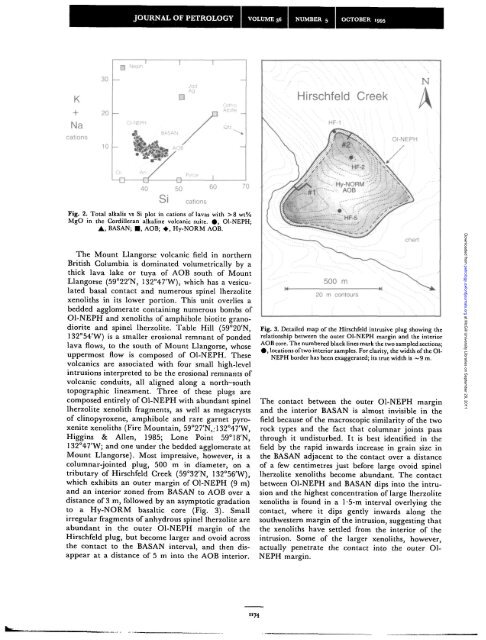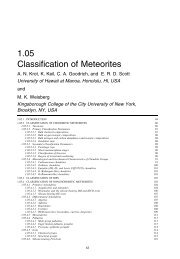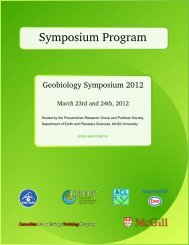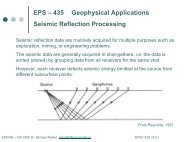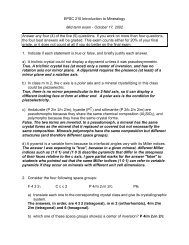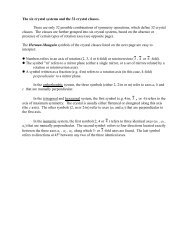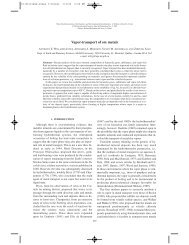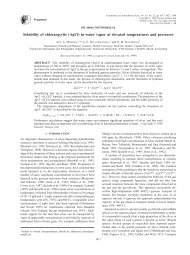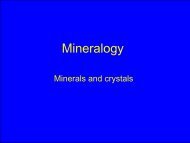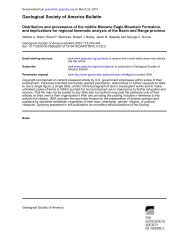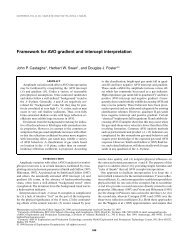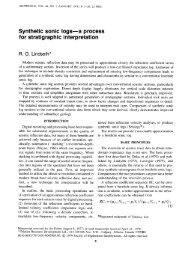The Signature of Amphibole in Mafic Alkaline Lavas, a Study in the ...
The Signature of Amphibole in Mafic Alkaline Lavas, a Study in the ...
The Signature of Amphibole in Mafic Alkaline Lavas, a Study in the ...
You also want an ePaper? Increase the reach of your titles
YUMPU automatically turns print PDFs into web optimized ePapers that Google loves.
JOURNAL OF PETROLOGY VOLUME 36 NUMBER 5 OCTOBER i 995<br />
B<br />
i<br />
| Negr><br />
i<br />
1<br />
K<br />
+<br />
Na<br />
cations<br />
30<br />
20<br />
10<br />
—<br />
-<br />
Ol-NEPH<br />
BASAN<br />
n^. AOB<br />
Jad<br />
Ag<br />
•<br />
f<br />
Ortho<br />
Albite<br />
—<br />
—<br />
Hirschfeld Creek<br />
N<br />
A<br />
Ol<br />
Af<br />
I<br />
J<br />
i d-<br />
D-<br />
40 50 60 70<br />
cations<br />
Fig. 2. Total alkalis vs Si plot <strong>in</strong> cations <strong>of</strong> lavas with >8 wt%<br />
MgO <strong>in</strong> <strong>the</strong> Cordilleran alkal<strong>in</strong>e volcanic suite. •, Ol-NEPH;<br />
A, BASAN; •, AOB; •, Hy-NORM AOB.<br />
<strong>The</strong> Mount Llangorse volcanic field <strong>in</strong> nor<strong>the</strong>rn<br />
British Columbia is dom<strong>in</strong>ated volumetrically by a<br />
thick lava lake or tuya <strong>of</strong> AOB south <strong>of</strong> Mount<br />
Llangorse (59°22'N, 132°47'W), which has a vesiculated<br />
basal contact and numerous sp<strong>in</strong>el lherzolite<br />
xenoliths <strong>in</strong> its lower portion. This unit overlies a<br />
bedded agglomerate conta<strong>in</strong><strong>in</strong>g numerous bombs <strong>of</strong><br />
Ol-NEPH and xenoliths <strong>of</strong> amphibole biotite granodiorite<br />
and sp<strong>in</strong>el lherzolite. Table Hill (59°20'N,<br />
132°54'W) is a smaller erosional remnant <strong>of</strong> ponded<br />
lava flows, to <strong>the</strong> south <strong>of</strong> Mount Llangorse, whose<br />
uppermost flow is composed <strong>of</strong> Ol-NEPH. <strong>The</strong>se<br />
volcanics are associated with four small high-level<br />
<strong>in</strong>trusions <strong>in</strong>terpreted to be <strong>the</strong> erosional remnants <strong>of</strong><br />
volcanic conduits, all aligned along a north-south<br />
topographic l<strong>in</strong>eament. Three <strong>of</strong> <strong>the</strong>se plugs are<br />
composed entirely <strong>of</strong> Ol-NEPH with abundant sp<strong>in</strong>el<br />
lherzolite xenolith fragments, as well as megacrysts<br />
<strong>of</strong> cl<strong>in</strong>opyroxene, amphibole and rare garnet pyroxenite<br />
xenoliths (Fire Mounta<strong>in</strong>, 59°27'N,;132°47'W,<br />
Higg<strong>in</strong>s & Allen, 1985; Lone Po<strong>in</strong>t 59°18'N,<br />
132°47'W; and one under <strong>the</strong> bedded agglomerate at<br />
Mount Llangorse). Most impressive, however, is a<br />
columnar-jo<strong>in</strong>ted plug, 500 m <strong>in</strong> diameter, on a<br />
tributary <strong>of</strong> Hirschfeld Creek (59°32'N, 132°56'W),<br />
which exhibits an outer marg<strong>in</strong> <strong>of</strong> Ol-NEPH (9 m)<br />
and an <strong>in</strong>terior zoned from BASAN to AOB over a<br />
distance <strong>of</strong> 3 m, followed by an asymptotic gradation<br />
to a Hy-NORM basaltic core (Fig. 3). Small<br />
irregular fragments <strong>of</strong> anhydrous sp<strong>in</strong>el lherzolite are<br />
abundant <strong>in</strong> <strong>the</strong> outer Ol-NEPH marg<strong>in</strong> <strong>of</strong> <strong>the</strong><br />
Hirschfeld plug, but become larger and ovoid across<br />
<strong>the</strong> contact to <strong>the</strong> BASAN <strong>in</strong>terval, and <strong>the</strong>n disappear<br />
at a distance <strong>of</strong> 5 m <strong>in</strong>to <strong>the</strong> AOB <strong>in</strong>terior.<br />
1<br />
500 m<br />
20 m contours<br />
Fig. 3. Detailed map <strong>of</strong> <strong>the</strong> Hirschfeld <strong>in</strong>trusive plug show<strong>in</strong>g <strong>the</strong><br />
relationship between <strong>the</strong> outer Ol-NEPH marg<strong>in</strong> and <strong>the</strong> <strong>in</strong>terior<br />
AOB core. <strong>The</strong> numbered black l<strong>in</strong>es mark <strong>the</strong> two sampled sections;<br />
#, locations <strong>of</strong> two <strong>in</strong>terior samples. For clarity, <strong>the</strong> width <strong>of</strong> <strong>the</strong> Ol-<br />
NEPH border has been exaggerated; its true width is ~9 m.<br />
<strong>The</strong> contact between <strong>the</strong> outer Ol-NEPH marg<strong>in</strong><br />
and <strong>the</strong> <strong>in</strong>terior BASAN is almost <strong>in</strong>visible <strong>in</strong> <strong>the</strong><br />
field because <strong>of</strong> <strong>the</strong> macroscopic similarity <strong>of</strong> <strong>the</strong> two<br />
rock types and <strong>the</strong> fact that columnar jo<strong>in</strong>ts pass<br />
through it undisturbed. It is best identified <strong>in</strong> <strong>the</strong><br />
field by <strong>the</strong> rapid <strong>in</strong>wards <strong>in</strong>crease <strong>in</strong> gra<strong>in</strong> size <strong>in</strong><br />
<strong>the</strong> BASAN adjacent to <strong>the</strong> contact over a distance<br />
<strong>of</strong> a few centimetres just before large ovoid sp<strong>in</strong>el<br />
lherzolite xenoliths become abundant. <strong>The</strong> contact<br />
between Ol-NEPH and BASAN dips <strong>in</strong>to <strong>the</strong> <strong>in</strong>trusion<br />
and <strong>the</strong> highest concentration <strong>of</strong> large lherzolite<br />
xenoliths is found <strong>in</strong> a 15-m <strong>in</strong>terval overly<strong>in</strong>g <strong>the</strong><br />
contact, where it dips gently <strong>in</strong>wards along <strong>the</strong><br />
southwestern marg<strong>in</strong> <strong>of</strong> <strong>the</strong> <strong>in</strong>trusion, suggest<strong>in</strong>g that<br />
<strong>the</strong> xenoliths have settled from <strong>the</strong> <strong>in</strong>terior <strong>of</strong> <strong>the</strong><br />
<strong>in</strong>trusion. Some <strong>of</strong> <strong>the</strong> larger xenoliths, however,<br />
actually penetrate <strong>the</strong> contact <strong>in</strong>to <strong>the</strong> outer Ol-<br />
NEPH marg<strong>in</strong>.<br />
Downloaded from petrology.oxfordjournals.org at McGill University Libraries on September 29, 2011<br />
1174


